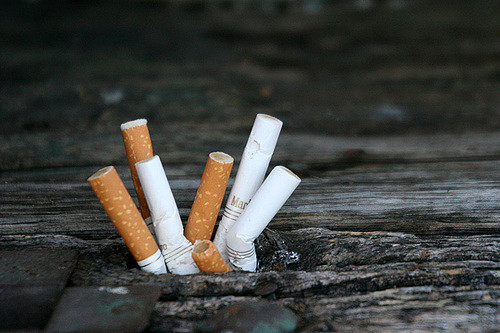Of the estimated seven billion people living on our planet right now, the World Health Organization says that one billion of us are cigarette smokers, producing about six trillion cigarette butts each year, and creating about 1.2 trillion tons of cigarette butt waste.
Those numbers are expected to increase by as much as 50 percent by 2025 as the world population grows.
That’s a real drag.
Not only are we creating a human disaster that kills about six million people every year, it’s our waterways that are taking a hit. Trillions of cigarette butts have ended up in them, harming fresh and saltwater fish and leaching heavy metals like arsenic, chromium, nickel and cadmium into soil and water.
Ocean Conservancy collected over two million discarded cigarette butts from oceans during its annual International Coastal Cleanup in 2013, making butts the #1 pollutant collected. Of those, over half were collected off the coasts of the United States, making the U.S. the top cigarette butt trash producer in the world.
Cigarette butts are a huge problem because even though they begin to break down a little after 12 years, they never actually degrade completely. Yet minutes after hitting the water, the deadly heavy metals inside the filters begin to seep out.
An innovative solution from Australian researchers may hold the key.
A Royal Melbourne Institute of Technology (RMIT) team led by Dr. Abbas Mohajerani has decided to build on this problem—literally. They found that producing bricks with as little as one percent cigarette butt content can make bricks cheaper to manufacture, give them better insulation properties, and keep the harmful heavy metals within the butts from polluting the environment.
And, according to the RMIT study published in ScienceDaily, if producers substituted only 2.5 percent of the world’s bricks with a one percent composition of cigarette butts, we could “completely offset the worldwide, annual cigarette production.”
What’s more, Mohajerani and his team found that adding cigarette butts cut the energy needed to fire bricks by 58 percent, reducing environmental impact and making them cheaper to produce. Bricks that contain butts were not only strong, they were also lighter with better insulation properties. This translates to reduced household heating and cooling costs.
Mohajerani was quoted by ScienceDaily, saying, “Incorporating butts into bricks can effectively solve a global litter problem as recycled cigarette butts can be placed in bricks without any fear of leaching or contamination.”
This is exciting news in a world in which the struggle to keep up with human-caused pollution feels like a losing battle. There have been a few other innovative solutions for cigarette butt pollution, like turning them into energy storage material for electronics components, and using them to create anti-rust treatments, but eco-friendly bricks are building hope that perhaps we can begin to turn the tide on the damage cigarette butts are doing to oceans, one of our most precious resources.
Author: Amanda Christmann
Editor: Catherine Monkman
Image: Dennis Hill/Flickr








Read 0 comments and reply